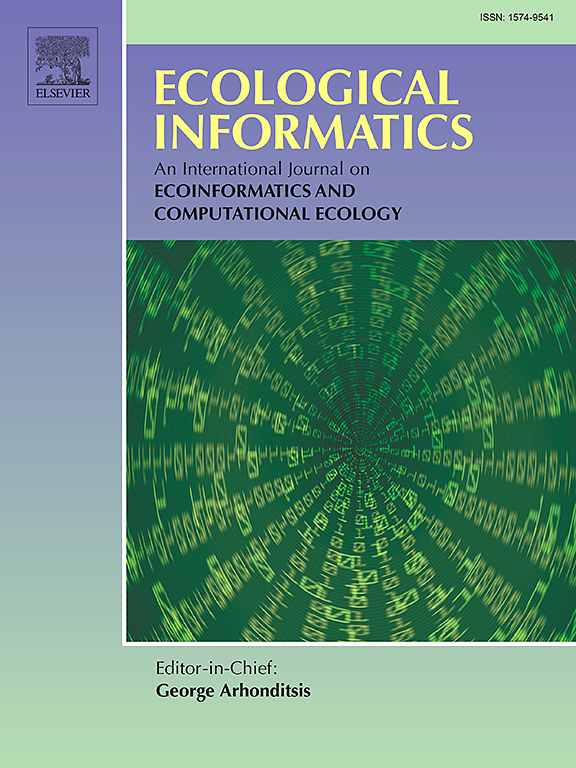Automated long-term monitoring of stereotypical movement in polar bears under human care using machine learning
IF 5.8
2区 环境科学与生态学
Q1 ECOLOGY
引用次数: 0
Abstract
The welfare of animals under human care is often assessed by observing behaviours indicative of stress or discomfort, such as stereotypical behaviour (SB), which often shows as repetitive, invariant pacing. Traditional behaviour monitoring methods, however, are labour-intensive and subject to observer bias. Our study presents an innovative automated approach utilising computer vision and machine learning to non-invasively detect and analyse SB in managed populations, exemplified by a longitudinal study of two polar bears. We designed an animal tracking framework to localise and identify individual animals in the enclosure. After determining their position on the enclosure map via homographic transformation, we refined the resulting trajectories using a particle filter. Finally, we classified the trajectory patterns as SB or normal behaviour using a lightweight random forest approach with an accuracy of 94.9 %. The system not only allows for continuous, objective monitoring of animal behaviours but also provides insights into seasonal variations in SB, illustrating its potential for improving animal welfare in zoological settings. Ultimately, we analysed 607 days for the occurrence of SB, allowing us to discuss seasonal patterns of SB in both the male and female polar bear monitored. This work advances the field of animal welfare research by introducing a scalable, efficient method for the long-term, automated detection and monitoring of stereotypical behaviour, paving the way for its application across various settings and species that can be continuously monitored with cameras. We made the code publicly available at https://github.com/team-vera/stereotypy-detector.

利用机器学习对人类看护下的北极熊的定型运动进行长期自动监测
人类通常通过观察动物的应激或不适行为来评估动物的福利,例如刻板行为(SB),通常表现为重复、不变的踱步。然而,传统的行为监测方法需要耗费大量人力,而且会受到观察者偏差的影响。我们的研究提出了一种创新的自动化方法,利用计算机视觉和机器学习,以两只北极熊的纵向研究为例,对管理种群中的SB进行非侵入式检测和分析。我们设计了一个动物追踪框架,用于定位和识别围栏中的动物个体。通过同源变换确定动物在围栏地图上的位置后,我们使用粒子滤波器对得到的轨迹进行细化。最后,我们使用轻量级随机森林方法将轨迹模式划分为 SB 或正常行为,准确率高达 94.9%。该系统不仅可以对动物行为进行连续、客观的监测,还能深入了解 SB 的季节性变化,从而说明其在改善动物园动物福利方面的潜力。最终,我们分析了 607 天的 SB 发生情况,从而讨论了所监测的雄性和雌性北极熊的 SB 季节性模式。这项工作引入了一种可扩展的高效方法,用于长期自动检测和监控动物的刻板行为,从而推动了动物福利研究领域的发展。我们在 https://github.com/team-vera/stereotypy-detector 上公开了代码。
本文章由计算机程序翻译,如有差异,请以英文原文为准。
求助全文
约1分钟内获得全文
求助全文
来源期刊

Ecological Informatics
环境科学-生态学
CiteScore
8.30
自引率
11.80%
发文量
346
审稿时长
46 days
期刊介绍:
The journal Ecological Informatics is devoted to the publication of high quality, peer-reviewed articles on all aspects of computational ecology, data science and biogeography. The scope of the journal takes into account the data-intensive nature of ecology, the growing capacity of information technology to access, harness and leverage complex data as well as the critical need for informing sustainable management in view of global environmental and climate change.
The nature of the journal is interdisciplinary at the crossover between ecology and informatics. It focuses on novel concepts and techniques for image- and genome-based monitoring and interpretation, sensor- and multimedia-based data acquisition, internet-based data archiving and sharing, data assimilation, modelling and prediction of ecological data.
 求助内容:
求助内容: 应助结果提醒方式:
应助结果提醒方式:


